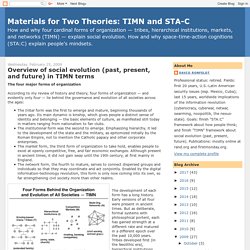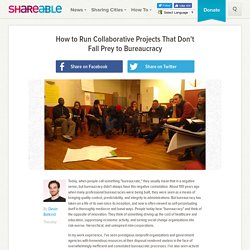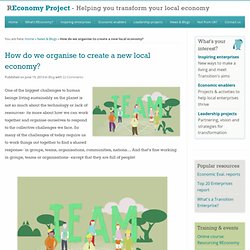Zoom
Trash

TIMN and STA-C: Overview of social evolution (past, present, and future) in TIMN terms. The four major forms of organization According to my review of history and theory, four forms of organization — and evidently only four — lie behind the governance and evolution of all societies across the ages: The tribal form was the first to emerge and mature, beginning thousands of years ago.

Its main dynamic is kinship, which gives people a distinct sense of identity and belonging — the basic elements of culture, as manifested still today in matters ranging from nationalism to fan clubs. The institutional form was the second to emerge. How to Run Collaborative Projects That Don't Fall Prey to Bureaucracy. Today, when people call something "bureaucratic," they usually mean that in a negative sense, but bureaucracy didn't always have this negative connotation.

About 100 years ago when many professional bureaucracies were being built, they were seen as a means of bringing quality control, predictability, and integrity to administrations. Materials for Two Theories: TIMN and STA-C: TIMN in 20 minutes: a video presentation. Here’s a video that offers an overview about the TIMN framework, its system dynamics, and some future implications.

It was filmed at my home in order to enable a presentation about TIMN at recent Highlands Forum meetings, after I demurred about traveling to participate in them. The presentation proceeds in three segments. Segment One is about how TIMN got started. It provides background and a basic description of TIMN. Segment Two is about how TIMN works. Why Bad Behavior is Almost Always Good Politics. Most great thinkers have speculated about the kind of leadership that might give rise to a better society, analyzing it through what’s sometimes called a “normative” lens: What should we be doing?

In Leviathan, for example, Thomas Hobbes argued for a single, absolute sovereign to hold together the social contract. He was addressing a debate over how leaders should act—whether they should follow their citizens’ wishes or act in the interests of future generations, against current pressures. Startups be warned: Something weird happens to companies when they hit 150 people — Quartz.
The dynamics of companies change fundamentally when they exceed roughly 150 people, in ways that startup founders can struggle to address.

“It’s one of the magic numbers in group sizes,” contends Facebook chief product officer Chris Cox, who joined in 2005 when the internet company had fewer than 100 employees. “I’ve talked to so many startup CEOs that after they pass this number, weird stuff starts to happen,” Cox said at the Aspen Ideas Festival this summer. “The weird stuff means the company needs more structure for communications and decision-making.” An online collaborator’s handbook: What it takes to get a group working online. : Indaba. I’d like to have a conversation about how online collaboration works, based on some things we learned while building the Indaba fieldwork platform, a tool for organizations that use distributed teams to collect data or write reports.

Over the last ten years I have used, loved and hated online collaboration tools with teams in more than 100 countries. It’s not magic. Online collaboration is simply getting stuff done over the Internet, and online collaboration tools, all of them, have some means of addressing three functions: relationship management, knowledge management, and project management. Loomio. Quick Guide To Coworking Space Management Software. Running a coworking space is no easy task.

Mostly because it’s about way more than running a space. Designing and Building the Blueprint of WE: The State of Grace Document Collaboration Process (5:00) The Blueprint of WE. What Is the Blueprint of We?

(formerly named the State of Grace Document) Sustainable Collaboration A collaboration process used to build and sustain healthier, more resilient business and personal relationships, making your day-to-day interactions effortless and your time together creative and productive. Beyond self awareness, our world now demands Collaborative Awareness; how can we do this fast-paced dance without stepping on each other’s toes? Morality Quiz/Test your Morals, Values & Ethics - Your Morals.Org. New Organizing Institute. Heterarchy. Enlightened co-operative governance. Hierarchy Is Overrated - Tim Kastelle. By Tim Kastelle | 2:00 PM November 20, 2013 Maybe you’ve heard the old cliché – if you’ve got “too many chiefs,” your initiative will fail.

Every time I hear it, I wonder, “Why can’t everyone be a chief?” For instance, the Second Chance Programme is a group that raises money to help reduce homelessness among women here in Southeast Queensland. How do we organise to create a new local economy? You are here: Home » News & Blogs » How do we organise to create a new local economy?

One of the biggest challenges to human beings living sustainably on the planet is not so much about the technology or lack of resources- its more about how we can work together and organise ourselves to respond to the collective challenges we face. So many of the challenges of today require us to work things out together to find a shared response- in groups, teams, organisations, communities, nations…. Holacracy. Holacracy = An organizational governance system developed by Brian Robertson through incremental testing in his software company Ternary Software, in the early 2000's.
Holacracy was influenced by many methods such as agile software development, Getting Things Done®, Sociocracy, and several others. Beyond the Holacracy Hype. It was a Thursday afternoon in Las Vegas. Five employees were camped out in a team room at Zappos, the largest company so far to implement holacracy—a form of self-management that confers decision power on fluid teams, or “circles,” and roles rather than individuals. On this particular day, in May 2015, the circle charged with overseeing holacracy’s adoption was questioning the method’s effectiveness.
A couple of months earlier, Zappos CEO Tony Hsieh had offered severance packages to all employees for whom self-management was not a good fit—or who wished to leave for any other reason. Although most decided to stay, 18% took the package, with 6% citing holacracy. In exit interviews and surveys, the 6% shared their concerns. Our research and experience tell us that elements of self-organization will become valuable tools for companies of all kinds.
How It Works. Distributed Authority Holacracy is a distributed authority system – a set of “rules of the game” that bake empowerment into the core of the organization. Unlike conventional top-down or progressive bottom-up approaches, it integrates the benefits of both without relying on parental heroic leaders. Everyone becomes a leader of their roles and a follower of others’, processing tensions with real authority and real responsibility, through dynamic governance and transparent operations. Related reading: Blog post: Empowerment is Dead; Long Live Empowerment Related reading: The Holacracy Constitution: the actual rules of Holacracy. Holacracy Introduction Webinar 2012-10-03. Social Technology for Purposeful Organization. Differentiating Organization & Tribe.
Horizontalism and Territory. Brazil uprising points to rise of leaderless networks - life - 26 June 2013. Horizontalism. We began learning together. Towards Collaborative Community. Cooperation, Coordination, and Collaboration. In networks, cooperation trumps collaboration. In networks, cooperation trumps collaboration. Collaboration happens around some kind of plan or structure, while cooperation presumes the freedom of individuals to join and participate.
'Networked minds' require fundamentally new kind of economics. Why Employees Prefer Management Hierarchies. Simon Sinek: Why Leaders Eat Last. Fear and Guilt Cultures. Co-opoly: The Game of Co-operatives - The Toolbox for Education and Social Action. Order Co-opoly in the UK In Co-opoly: The Game of Cooperatives, players collaborate to found and run a democratic business. Nomic.net: home of nomic stuff. Class Struggle Board Game Rules < DIALECTICAL MARXISM: The Writings of Bertell Ollman.